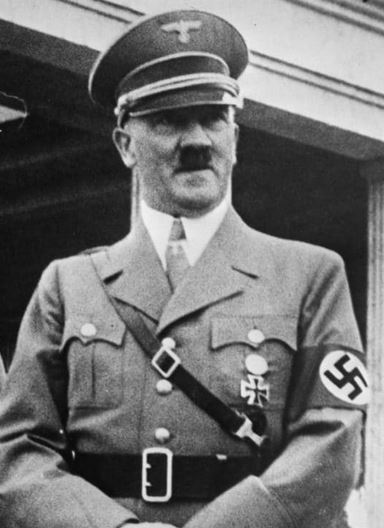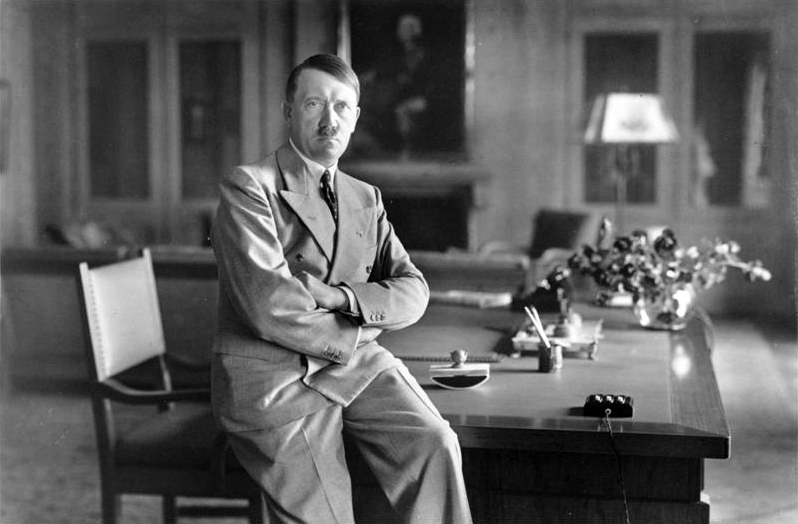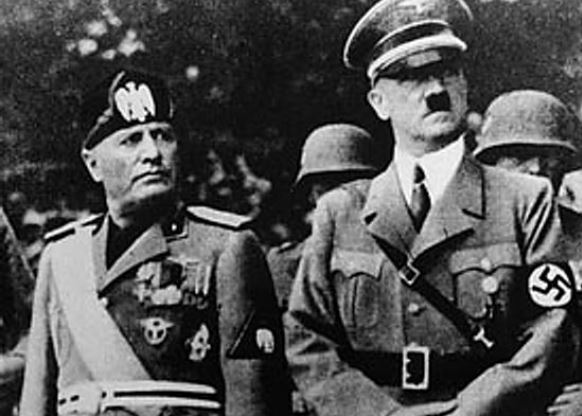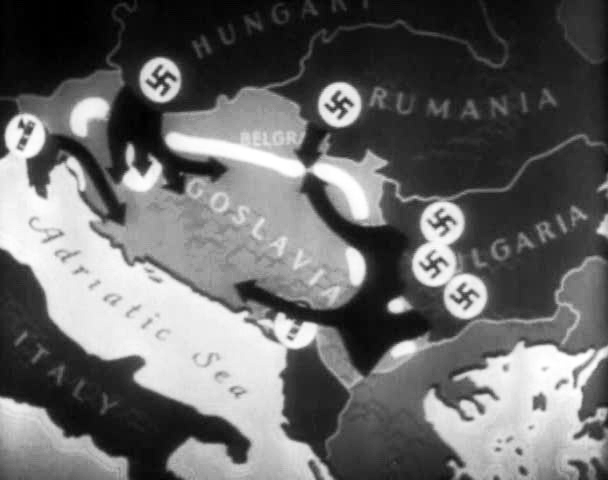Period:
Second World War
Region:
Yugoslavia
The German criminal Adolf Hitler, Nazi leader (1889-1945)
Adolf Hitler (1889-1945) was the German chancellor during the period from 1933 to 1945, when he plunged the world into the Second World War. Although he was born an Austrian, he fought as a volunteer in the German army, on the Western Front during the First World War.
He did not accept the defeat of Germany in WWI so he wanted the war to continue. He made the Tripartite (Berlin) Pact with Italy and Japan on 27 September 1940.

Angered by the fact that the Serbian people rejected the decision of the Government of the Kingdom of Yugoslavia on the passage of its troops through Yugoslav territory, he ordered the attack and subjugation of the Kingdom of Yugoslavia (Operation Directive 25). Thus, on 6 April 1941, together with his allies (Hungary, Italy, Albania and Bulgaria), he carried out an act of aggression against the first South Slavic state and divided it. On that occasion, only Serbian cities were bombed, and German aviation bombs also fell on the maternity hospital in Belgrade.
Later, Wehrmacht troops committed crimes against Serb civilians according to the mandate: "Kill 100 Serbs for one German and kill 50 Serbs for one wounded German". Thus, German forces in occupied Serbia committed horrific crimes in Draginac, Kraljevo, Kragujevac, Kozara etc.
He was never tried for his crimes because he allegedly committed suicide on 30 April 1945, although there is speculation that he fled with his wife to Argentina, where he lived into old age and had two daughters.
|
GERMAN CRIMES AGAINST SERBS
|
| CRIMES |
Macva and Podrinje * Beshka * Belgrade's Occupation * Bombing Belgrade
Operation 25 * Occupation of Bosnia * Surdulica * Novi Pazar * Angel of Mercy
Gread Albania * Nish * Draginac * Kraljevo * Kragujevac * Kursumlija * Valjevo
Svilajnac * Smederevo castle * Velika * Valley of Piva * Pancevo * Grdelica
Kriva Reka * Blazevo and Bozoljin * Crna Stijena * Varvarin * Murino
Aberdareva Street
|
| CAMPS |
Kuberg * Jindrihovce * Mauthausen * Nezider * Aschach an der Donau
Nekenmarkt * Nadjmer * Boldogasszony * Broumov * Doboj * Arad * Dachau
Auschwitz * Meinheim* Baracks on Sava * Crveni Krst * Banjica * Karasjok
Sajmiste * Beisfjord *
|
| BATTLES |
Cer * Gucevo * Mackov Kamen * Kolubara * Cemerno * Mojkovac * Vrbovac
Kozara * Neretva * Sutjeska * Koshare * Pashtrik
|
| CRMINALS |
Helmut Kohl * Alfred Schenk * Petar Enger * Juraj Schpiler * Kurt Valdheim
Karl I Austrians * Oscar Pocorek * Walter Brauchitsch * Gerhard Schreder
Adolf Hitler * Josef Janko * Franc Beme * Fridrich Gisendorf * Evald Kleist
August Makenzen * Wilhem Reiner * Ludvig Kubler * Rudolf Scharping
|
|
VICTIMS
|
Draga Petronijevic * Sefko Tairovic * Stojanka Djokovic * Sanja Milenkovic
Jovan Klajic * Velimir Pavlovic * Dositej Vasic * Sava Trlajic *
|
|
PUBLICAT.
|
7,000 Souls * Beisfjord tragedy * Bloody roads * Black Book * |
BIOGRAPHY
Adolf Hitler was born on 20 April 1889, as the fourth of six children in the small town of Braunau am Inn, in northern Austria, on the border with Germany. His father's name was Alois, and his mother's name was Klara. Only two children managed to survive, the rest died as children.
Hitler's father Alois was excitable and aggressive by nature and he often beat his family. He was a customs officer by profession and his family often moved.
Adolf Hitler was a good student in elementary school and stood out among his peers. He had a bad period in high school, so he repeated the first year. Later on, he repeatedly needed to repeat exams, because he still wanted to do art, and not follow his father's wishes and become a state official.
After graduating from High School in 1905, he moved to Vienna, where he lived a debauched life, spending his father's pension on cafes and prostitutes. He failed to enroll in the Academy of Applied Arts twice and that affected him greatly.

Essential literature of European Right Wing
When he turned 21, Hitler began to support himself as a painter, selling paintings, which were copies from various postcards, to tourists. For a time, from 1909-1910, he lived in a home for the homeless and there he developed hatred towards Jews, because he saw their wealth (goldsmiths, insurance companies, factories, etc.) and believed that they had acquired it in a dishonest way.
During those years, his idol was Martin Luther, the leader of the Protestants.
Literature
In prison in 1924, Hitler wrote his famous work Mein Kamf, a book that was published in 1925 and sold 250,000 copies in nine years, which was quite large circulation at the time. He dedicated the book to Dietrich Eckart, a member of the Tula Secret Society.
It is noteworthy that Adolf Hitler avoided paying taxes on the sale of that book for years, so by 1933 his tax debt had grown to 405,000 German marks. When he became chancellor, that is. Prime Minister, the German state "forgave" him this debt.
THE FIRST WORLD WAR
In May 1913, Hitler moved to Munich (in the German state of Bavaria), where he lived on his father's estate. He was conscripted for mobilization in Austria-Hungary in 1914, but he skillfully avoided it for several months. In the end, however, he was still arrested by the Austrian police. He was released as a conscientious objector and he returned to Munich.

Nothing new in the West: Hitler Does Not Back Down
However, when Germany entered the First World War, he volunteered on 16 August 1914, joining the famous 16th Bavarian Regiment, with which he went to the Western Front. By the end of the year, he was promoted to the rank of corporal, although he worked as a courier.
He took part in the Battle of the Somme in July-November 1916 in the province of Picardy, in the north of France, where there were great losses on both sides, and Adolf himself was wounded and transferred for treatment near Berlin. In March 1917, he returned to his unit on the front, where he showed great courage.
In October 1918, before the end of the war, he barely survived the effects of poison gas used by the British army. He was transferred for treatment to the Pazevlak military hospital, in the northeastern province of Mecklenburg.
During the First World War, Adolf Hitler was awarded the highest German military order, the Iron Cross of the First Order.
THE INTER-WAR PERIOD AND ENTRANCE INTO POLITICS
After the end of the First World War, Hitler remained in the army until 31 March 1920. He returned to Munich. Not only did he refuse to accept the defeat of Germany, but also blamed politicians for their "shameful capitulation". He was an active participant in all German national events, although until 1932 he was not actually a citizen of Germany, but rather of Austria.
From 1919-1920, he was a member of the Intelligence Service of the German Army, and he was embedded into the German Workers' Party to gather information. He liked the thinking of the leaders of that party, and after leaving the military service, he continued to cooperate with their leaders, although they often did not have the same views.
However, Adolf Hitler began to give more and more fiery speeches in front of a larger number of people, several thousand each, which enabled him to have contacts with various people, including Erich Ludendorff, a German general. He organized the famous Beer Hall Putsch in Munich, on 8 November 1923, in which he attempted to seize power in Bavaria by force, but failed. There were firefights with police and the army, and some members of his failed coup were killed. After that, he was arrested and brought before a court, which he used for his political manipulations, while his popularity grew more and more, not only in Bavaria, but throughout Germany. Although he was sentenced to five years in prison by a Bavarian court on 1 April 1924, he was released after serving only eight months.
At the time, his party had 12 deputies in the German assembly - the Reichstag - and by 1930 it had already risen to 230 seats. At that time, he was already running for the presidency of Germany.
In the early 1930s, Germany was hit by a major economic crisis, which allowed Hitler to gain new supporters by criticizing international Jewry and criticizing the decisions of the 1919 Peace Treaty of Versailles (Germany was held responsible for the war and had to pay 132 billion gold francs).

From Homelessness to the Chancellor of Germany
In the elections in March 1933, Hitler won an incredible 44% of seats, which enabled him to become Secretary of State, and later, by changing the election law, he became the head of the German Government, that is, the chancellor. After seizing power, he began with purges, i.e. silent liquidations of all persons he deemed unsuitable, including Jews, homosexuals, etc.
He established close cooperation with the Italian fascist leader Benito Mussolini, who had similar attitudes and an equal desire for the "correction" of Post-Versailles Europe. Mussolini and Hitler together helped the Spanish dictator Franco, who managed to win in 1939 after three years of the Spanish Civil War.
On 8 November 1939, Hitler survived a Munich assassination attempt.
SECOND WORLD WAR
Hitler annexed Austria to Germany on 12 March 1938, an event which was known as the Anschluss, and in the following days he marched triumphantly to Vienna. He was not satisfied with that, and, with the tacit approval of Great Britain and France, on 10 March 1939, he ordered the invasion of Czechoslovakia. He also demanded that Poland return to Germany the territories it had received through the Treaty of Versailles in 1919.
On 23 August 1939, Hitler's Germany signed a non-aggression and partition agreement with the USSR. Subsequently, German war units carried out an attack against Poland on 1 September 1939, which is considered the beginning of the Second World War, because on the same day, France and Great Britain declared war on Germany.

The forging of the alliance between fascists and Nazis:
Benito Mussolini and Adolf Hitler
In March 1940, Hitler's forces marched into Norway and Denmark, and, two months later, into Belgium and the Netherlands. Then, on 27 September 1940, an agreement was officially signed in Berlin between Germany, Italy and Japan, which is considered to be the creation of the Tripartite, or Berlin, Pact. France and Germany signed armistice agreements on 22 June 1940.
AGRESSION ON YUGOSLAVIA
After the assassination of King Alexander the First (Karadjordjević) in Marseilles in 1934, the Kingdom of Yugoslavia was led by a triple viceroyalty, headed by Prince Paul Karadjordjević. The Yugoslav government headed by Prime Minister Cvetković and Vice Premier Maček tried to oppose the growing German Nazism by declaring neutrality in 1940, but that did not satisfy Hitler. He sought obedience.
Thus, on 25 March 1941, an agreement was signed near Vienna for the passage of German troops through Yugoslav territory. However, the Soviet Union and Great Britain saw this as a betrayal, although they were not ready to help Yugoslavia militarily. Two days later, a military coup was organized on 27 March 1941, directed by British intelligence and enacted through demonstrations in Belgrade and larger Serbian cities. Seventeen-year-old King Peter the Second Karadjordjević was appointed to power.
This angered Hitler, who wanted revenge for the fact that the Army of the Kingdom of Serbia and its allies broke through the Thessaloniki front in 1918 and decided the outcome of the First World War.

Attack on Yugoslavia from all sides
The April War
German military forces, which were planned to attack Greece, were redirected to the Kingdom of Yugoslavia. This criminal operation is called "Directive 25". Hitler wanted to quickly control the Serbs, as he was preparing for an attack on the USSR, which was postponed.
In addition to German troops, on 6 April 1941, Italy, Hungary, Bulgaria and Albania took part in the attack against the first South Slavic state, while Romania had to allow German forces to attack through its territory. Belgrade and several other Serbian cities (Osijek, Novi Sad, Valjevo, Niš, Split, Sarajevo, Banja Luka, Podgorica, etc.) were horribly bombed for several days. The bombs, which were labeled "Happy Easter", even fell on maternity hospitals.
As the Kingdom of Yugoslavia was now surrounded by a totally hostile environment, and no one had come to its aid, and taking into consideration the great betrayal of Slovenian and Croatian officers in the Army of the Kingdom of Yugoslavia, a breakdown was inevitable. Yugoslavia surrendered to the German Government on 17 April 1941, and was divided between the four Axis Governments.
In the meantime, King Peter II Karadjordjević and a good part of his government were evacuated via Egypt to London, where they were kept under house arrest. The last decision of the Yugoslav royal government from the session from Nikšić on 15 April 1941 was to sign an armistice with Germany and stating that the state would not surrender even if the army had to.

Meeting of Ante Pavelić and Hitler
Occupation and division of Yugoslavia
Slovenia was annexed to Germany and became part of the German Reich. Hitler gave the Croats the Independent State of Croatia, which, in addition to Zagorje, included Slavonia, Srem, Bosnia, Herzegovina, a small part of Dalmatia, Lika, Kordun, Banija and Gorski Kotari.
Most of Dalmatia was given to the Italians. Kosovo and Metohija became part of Greater Albania, under Italian protectorate, along with Montenegro. The Bulgarians got the Vardar part of Serbia, together with the South Moravian and Timok part. Bačka and Baranja became part of Horthy's Hungary.
Serbia was reduced to its pre-1878 borders and the Quisling Government of Milan Nedić was established there. In addition, Banat was created as an annex to occupied Serbia, but with a special status, because all power was given to the ethnically German Volksdeutscher – known as the Danube Germans.
WAR CRIMES AND GENOCIDE
Serbs and Jews (called Židovi) came under attack in all occupied parts of the Kingdom of Yugoslavia. There is almost no place where the Nazis together with their allies, the Balli Kombëtar (Ballists), Volksdeutscher, the Hungarian quizlings (Horthy), the Croatian Revolutionary Ustashas and others, did not commit war crimes.

Bloody Nazi traces in Draginac
Among the well-known crimes of the Nazis are:
Pančevo, 1941 - German forces, aided by the local Volksdeutscher hanged 36 Serbs in the center of Pančevo, as a warning to Serbs.
Kraljevo, 1941 - German forces massacred 2,190 Serbs, in retaliation for the activities of Serbian guerrillas in October 1941.
Draginac, 1941 - Nazi units in the villages of Loznica: Draginac, Čokešini, Tekeriš, Nedeljkovac and others, massacred about 3,000 Serbs.
Kragujevac, 1941- German units shot about 2,800 Serbs, mostly elderly and children under the age of 14, as an act of revenge and intimidation of Serbs
The Banjica camp was the largest concentration camp under the management of the German GESTAPO. About 3,800 Serbs and Jews were killed there. About 30,000 people passed through the camp.
The Barracks on the Sava river was one of three German camps in Šabac. About 2,500 Serbs were killed there, and about 30,000 Serbs passed through its walls.
The Red Cross camp was one in a series of Nazi camps in Niš, where close to 10,000 Serbs were killed, mostly at the Bubanj location, Over 30,000 Serbs were imprisoned here.
The Sajmište camp in Zemun officially belonged to the Independent State of Croatia, but the camp administration was run by commanders from the German SS unit. 8,000 Jews and 32,000 Serbs were imprisoned there. They were mostly killed in gas chambers or sent to Jajinci for execution.

The Germans escort the Serbs from Kozara
with the Croatian fascistic troops
In addition, the German army took part in many criminal operations, such as "Weiss 1", "Weiss 2", "Schwartz", then the Battle of Kozara in Bosnia, the Battle of Pivski Dol in Montenegro and others.
DEFEAT AND DEATH
Hitler's army suffered its first great defeat near Moscow in December 1941, and thereafter the Red Army destroyed everything in its path all the way to Berlin.
Later, the British and Americans defeated the German forces in Africa in 1942, as well as in the Atlantic, and the following year they landed in Italy and forced it to surrender in September 1943.
In June 1944, the Western Front (Operation Overlord) opened, as the British and Americans landed in the French province of Normandy. Adolf Hitler himself saw that the Allies were closing him down from all sides, but he hoped for a new super-weapon; an atomic bomb, which he did not manage to get.
The official theory says that Hitler committed suicide in the Reichstag on 30 April 1945, and that his body, together with his mistress Eva Braun was doused with gasoline and set on fire.
Germany lost the war and was divided into 4 zones: Soviet, French, British and American. The Soviet part of Germany became the German Democratic Republic, and the American, French and British parts were later united into the Federal Republic of Germany.
Decades later, after the fall of the Berlin Wall in 1989 and the unification of Germany in 1990, speculations arose about Hitler's evacuation at the end of April 1945 through a secret tunnel and then by plane via Denmark and Spain to Argentina, where he allegedly died in 1962.

Although recorded in history as a negative phenomenon, in recent years Hitler gained more and more admirers. Members and sympathizers of the ultra-right movement perceive him as an idol.
Tags:
Please, vote for this article:
Visited: 3061 point
Number of votes: 15
|